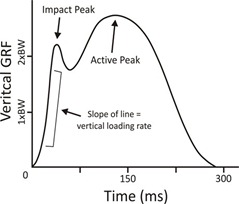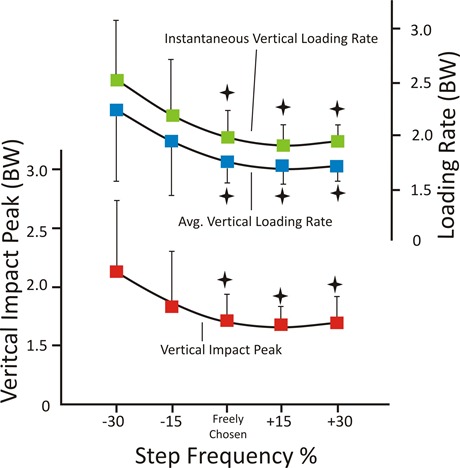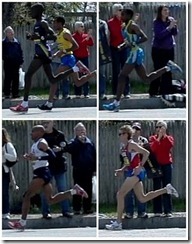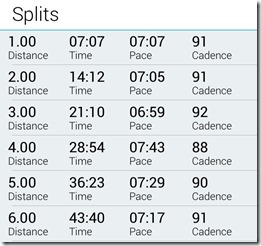 Just over a week ago Amby Burfoot wrote a post about a new study from Japan that provides additional evidence supporting the benefits of a shorter stride for reducing loading of the lower limbs. The study by Hobara et al. is titled Step Frequency and Lower Extremity Loading During Running and was published in Orthopedics and Biomechanics. I thought I’d follow up with a few thoughts of my own.
Just over a week ago Amby Burfoot wrote a post about a new study from Japan that provides additional evidence supporting the benefits of a shorter stride for reducing loading of the lower limbs. The study by Hobara et al. is titled Step Frequency and Lower Extremity Loading During Running and was published in Orthopedics and Biomechanics. I thought I’d follow up with a few thoughts of my own.
In the study, Hobara et al. wanted to determine how increasing or decreasing step rate would influence vertical impact force and vertical impact loading rate during foot strike (see first peak on the image above or read this post for a detailed discussion of these variables). Vertical loading rate has been linked to some types of running injuries (e.g., stress fractures), and the idea was to determine whether altering stride rate could lead to alteration of loading, and thus possibly reduce injury risk.
The study itself was fairly simple. They had 10 subjects run on an instrumented treadmill at 2.5 m/s (about a 10:45 min/mile pace) at five different step rates: freely chosen step rate, and –30%, –15%, +15%, and +30% of the freely chosen step rate. Modifying step rate at a constant pace results in a change in stride length, so increased step rates lead to a shorter stride, and decreased step rates lead to a longer stride. The researchers monitored peak impact force, instantaneous vertical loading rate (VILR; this is the peak loading rate observed during impact), and average vertical loading rate (VALR) as each runner ran on the treadmill.
Results are pretty well summarized in the following figure adapted from Hobara et al. 2012 (any errors in reproduction are my own – I recreated it to avoid copyright issues):
The stars in the above figure indicate values that are significantly different from that observed at the –30% step frequency. This implies that running with a really slow step rate/long stride significantly increases impact force and the rate at which that force is applied. Though there appear to not be significant differences among the other stride frequencies, a quadratic regression analysis found that impact peak, VILR, and VALR were all minimized at a step rate of roughly 17-18% higher than the freely chosen step rate (i.e., this is the low point of the black curved lines fit to the sample data for each step frequency). Data for individuals were unfortunately not provided.
This is not the first study to suggest that a shorter, quicker stride might be beneficial when it comes to reducing loading of the lower limb. Others have found similar results (e.g., read this post on stride length and leg joint loading), and the topic has received a lot of attention of late. In fact, I wrote an entire chapter on the topic in my forthcoming book that summarizes historical advice on stride length as well as what modern science has to say about the topic. I’ve come to the conclusion that stride length is likely one of the more important form characteristics to consider when it comes to reducing injury risk. Though there is a great deal of debate about proper foot strike, most people seem to agree that overstriding is bad, and there appears to be some solid science backing this up.
Limitations of this study are that it’s difficult to say whether the results are generalizable to runners across a range of paces (all ran at a 10:45 min/mile pace here). It’s also difficult to know whether treadmill-derived results are applicable to overground running. Nonetheless, the fact that these results are consistent with previous research on the topic adds further support for the use of stride length modification as one potential tool in the prevention and treatment of running injuries.

















To be honest, I think the sample size is quite small. As you concluded – although this study is consistent with previous research, it’s still insufficient to generalize the results based on 10 male runners “running” at 10:45 min/mile pace.
Coming from a biomedical engineering background, I noticed that many biomechanical studies are conducted on the treadmill for the ease of manipulating the control variable such as pace. Prior to partaking distance running after grad school, I had no idea how drastically different it is to run on the road from the treadmill. This is why sometimes I suspect that many researchers aren’t runners themselves. Pete, Have you come across similar studies done on the road with a larger sample size?
No, sample sizes are typically fairly small for this type of study. The problem with doing overground studies that address this type of question is that it requires that people run over a force plate, which always makes one wonder about plate targeting and alteration of stride to hit the plate – I ahve a hard enough time not being conscious of my form just when passing by a video camera, let alone trying to step on a particular spot. I don’t put much stock in results of studies that merely have people run along a short runway to hit a force plate. Until we get mobile force sensors that can do this inside a shoe without being too cumbersome we are restricted to treadmill data. I think one of the big things we are lacking in running research is more “real world” data. That’s one of the reasons I have enjoyed filming road races in slow-mo – can’t measure forces, but get to see what people really do out on the road.
Interesting study, Pete. I think that the slow pace may be a problem. If asked to run at 10:45 min/mile, I think most of us would have to alter our natural cadence and stride length. It would be also interesting to know what the runners’ absolute cadence was, rather than just their cadence relative to their “freely chosen” cadence.
Yes, I think most people would tend to have a fairly short stride at that pace. I suspect the results would be more pronounced in favor of a slightly shorter stride at faster paces for reducing impact, but that’s just a guess.
A few thoughts, largely related to the drawbacks of the study:
1) This is probably a limitation of the vertical loading rate measurements (you stated that the study was conducted on an ‘instrumented treadmill’), but I’m not familiar enough to know if it is or not: do these measurements require the use of a specialized treadmill? Is it possible to actually make these measurements on pavement without significantly altering the running experience? My intuition says no — inserting sensors into a shoe would likely have a non-negligible effect on the runners’ stride.
2) Related to this point — and Kevin’s point as well — it’s fairly well-known colloquially that treadmill running is far different from road running. How well do these results translate to road running? Or, more to the point — how big a grain of salt do we need as a side dish?
3) These studies in general are great — and the more we learn about stride and impact and injury the better — but it seems that many studies are limited by sensing and data acquisition, at least from a minimal impact on the runner’s stride perspective. How much work goes into alleviating these issues? Sorry, I have to largely plead ignorance on this.
See my response to Kevin – treadmills probably provide the cleanest data we can get given the current technology, but we always have that question of how well it applies to running out on the road. I suspect the general pattern would hold, but there are clearly some differences between treadmill and overground running.
Regardless of statistical difficulties, in my anecdotal experience, I feel that I run more efficiently and am less prone to injury when I am focusing on a shorter stride/higher turnover. Currently injured (!) so not exactly a great case study, but I think this info is on the right track, anyway.
Irrelevant completely but when will you review the Hoka Mafate 2? :)
I think those would have an effect on my step rate and lower limb loads!
No plans currently – they don’t appeal much to me. I’d try them, but don’t want to pay that price just to try a shoe out.
Load of bullshit!
Look at the way the Africans run with a fast turn over and long stride!
It’s where you land that matters!
Here is all you need to know
SPRINTING AND RUNNING BIOMECHANICS
The elite Africans generally don’t overstride, and they lengthen their stride by extending the hip on the backside. This is not the case with recreational runners, who generally extend the leg in front and have poor hip extension. This is not an article describing how to run fast, it’s an article describing how to reduce loading.
Re: hip extension. Why does Newton, a great company educating runners on natural running technique, emphasize hip FLEXTION….”lifting the knees” using the core? Wouldn’t that prevent one from proper extension of the hips when running?
If you think of the flexors and extensors as rubber bands, when you stretch one it will help recoil into the other. So presumably hip flexion will stretch the hamstrings and glutes and cause them to maximize recoil. Not saying it’s right or wrong, just that it may be their reasoning. I don’t follow a particular form “school” of thought, though some are better than others.
http://runwitharthurlydiard.bl…
well didnt everyone kind of know this? i mean if you pull the stride in, its way less impact than if you stretch em out… i coulda told you that….
Great info Pete. I too will read ” tread lightly”, and look forward to your book. Hope things are going well with.
I can provide a little insight on the cadence issue. Two years ago, when I read the book ” born to run”, and first heard about midfoot striking, natural running and cadence, the Harvard study by draw. Lieberman opened my eyes to impact force related to foot strike. I was a heavy heal striker with a cadence of 156-160 spm. I taught myself to midfoot strike and worked on increasing my cadence. Before this process I was a 30-35 mile per week runner competing in primarily 5k races and running one marathon per hearing Boston qualifying times. That one marathon pretty much wiped out my knees, hip and lower back for a few months after.three months of transitioning to midfoot and increasing cadence, I am now running at 172 spm, averaging 50 miles per week, and have run 8 ultra marathons in the last 18 months, including a 100 miler last labor day. I just recently ran a personal best on a brutally hilly 30 course by 30 minutes. I give credit to the fact that I’m getting more comfortable with my stride and cadence. Quick and light is what I tell myself when I run. Having turned 51 a few months ago, I believe this new running style has renewed my love for distance running and affirmed the fact that you’re rep never too old to run a personal record.
Great story coach, and one I hear frequently. I have a buddy locally who has a very similar story. He’s an ultrarunner but had big shin problems when running long distance. Modified his stride and went to flat shoes and finished four 100 milers last year, winning one of them. Not saying everyone has to do it, but it clearly is of great benefit to some.
Classic underpowered study. Although this data shows a trend that is expected, the statistical significance is lacking. Only when forced to run slower than the naturally chosen stride right did you see a statistical difference. The faster stride rates surely were not statistically significant compared to the natural rate. Don’t confuse statistical significance with practical significance.
Yep, I agree. Sample size of 10 makes detecting differences problematic. I also suspect the magnitude of difference would increase at a faster pace. But, I think it supports the general idea that increasing cadence reduces loading, which has been shown by other studies and is something that is advocated as effective by some highly respected clinicians.
Great post, Pete. Interestingly, another study conducted in 2011 at the University of Wisconsin analyzed the same variables, but had a slightly better sample size and better measurement tools.
Some 45 healthy recreational runners were recruited to run on a
treadmill at their normal easy run pace (between eight and nine minutes
per mile for most). Using 3D cameras and force plates, the
researchers analyzed the stride characteristics of the runners. After a control run, the runners were asked to increase
or decrease their stride frequencies by 5 and 10% for four additional
trials.
Using computer modeling, the researchers were able to piece
together exactly how the body distributed the impact force amongst the
ankles, knees, and hips. Though they didn’t measure the loading rate
directly, they monitored the impact transient—the spike in forces at
footstrike associated with a sharp loading rate.
As predicted, when the runners increased their stride rates, the
energy absorbed by the hip and knee joints decreased significantly
(interestingly, the energy absorbed by the ankle did not change
significantly). And sharp impact transients decreased at higher stride
frequencies.
The converse of this is also true: energy absorbed and
impact transients increased when the subjects were asked to decrease
their stride rate. The magnitude of the effects increased when the
subjects moved from ±5% to ±10%. So it appears that increasing
your stride frequency by five or ten percent is a good way to decrease
the impact loading on your joints and possibly prevent injury.
Thought you might be interested in that study and analysis. Wrote more about this here if you’re interested: link to runnersconnect.net…
Study here, meant to link it: link to ncbi.nlm.nih.gov…
Yes, I wrote about that one awhile ago, and it is featured in my book. Good one!